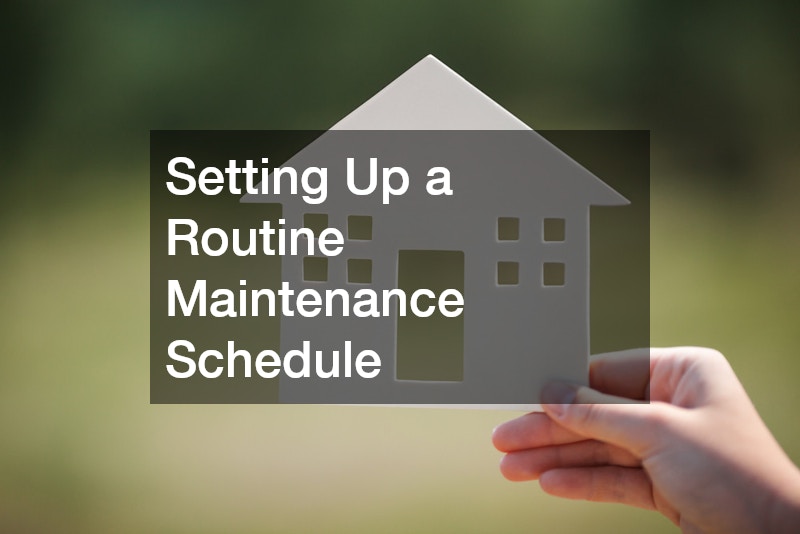Disclaimer: NC Pool Supply. This site provides home improvement content for informational purposes only.
Creating A Home Checklist To Make Life Easier
Managing a home efficiently requires organization, forethought, and an understanding of essential tasks that need to be done regularly. For many homeowners, creating a comprehensive house management checklist is the key to keeping everything in order, from routine maintenance to emergency preparedness. This checklist serves as a practical guide, helping you stay on top of important responsibilities, avoid unexpected repairs, and ensure the safety and comfort of your living space. With a structured approach, you can reduce the stress associated with home management and prevent common issues that may arise over time.
An effective house management checklist covers a variety of areas, including regular upkeep, safety inspections, and preparation for seasonal changes. By following a consistent routine, you can maintain your home’s appearance and functionality, as well as protect its long-term value. Each item on the list should be tailored to your specific needs, whether it’s scheduling regular cleanings, checking essential systems, or keeping up with minor repairs. This structured approach ensures you’re prepared for anything, creating a more organized and enjoyable living environment.

Setting Up a Routine Maintenance Schedule
Establishing a routine maintenance schedule is an essential part of any house management checklist, allowing you to stay on top of key tasks throughout the year. This includes regularly checking and maintaining various areas of your home, from plumbing and HVAC systems to windows and flooring. By setting specific dates or seasons for each task, you can avoid unexpected issues and ensure your home remains in good condition. Routine maintenance helps prevent larger, costly repairs by catching small problems early, making it an essential step for homeowners looking to manage their properties efficiently.
Incorporating services like a pressure washing company into your routine maintenance can further enhance the upkeep of your home. Pressure washing helps keep outdoor surfaces clean and free from dirt, mold, and grime, preserving your home’s exterior and curb appeal. Scheduling this type of service as part of your house management checklist ensures that your home’s exterior remains well-maintained, prolonging the lifespan of materials like siding, decks, and driveways. A regular maintenance schedule that includes specialized services keeps your property in optimal condition year-round, reducing the time and effort needed for extensive repairs.
Organizing Important Documents and Warranties
Keeping track of essential documents and warranties is a vital component of a well-structured house management checklist. Important papers like property deeds, mortgage documents, and appliance warranties should be organized and easily accessible. This system allows you to quickly locate necessary paperwork for repairs, insurance claims, or resale. Organizing documents also provides peace of mind, ensuring you have everything you need to address unexpected situations or routine tasks without the hassle of searching for misplaced items.
For specific maintenance services, such as a roof washing service, it’s useful to keep records of work done, warranties, and contact information for service providers. This ensures that you have a clear history of maintenance, which can be valuable for future repairs or when selling your home. Adding document organization to your house management checklist not only improves efficiency but also helps you maintain a comprehensive overview of your home’s upkeep and improvements. Keeping everything in one place makes it easy to reference information as needed, saving time and preventing frustration.

Creating an Emergency Preparedness Plan
An emergency preparedness plan is an essential component of any house management checklist, helping you and your family stay safe and ready for unexpected situations. This plan typically includes establishing emergency contacts, knowing evacuation routes, and keeping a supply kit on hand with essentials like water, food, and medical supplies. Preparing for emergencies ensures that you’re equipped to handle various scenarios, such as natural disasters, power outages, or household accidents. A well-thought-out plan provides peace of mind and keeps you ready to respond effectively to unforeseen events.
Adding emergency contact information for services, such as a residential home improvement provider, can be extremely helpful in case you need quick repairs due to damage from a storm or other emergency. By including such contacts in your emergency plan, you’re prepared to address immediate concerns that could impact your home’s safety and function. Incorporating emergency preparedness into your house management checklist keeps you organized and confident, knowing you have the resources and plans in place to protect your home and loved ones.
Managing Seasonal Home Care Tasks
Seasonal home care tasks are crucial for maintaining your property’s condition throughout the year. These tasks vary with the seasons, addressing specific needs like winterizing your home, preparing for spring cleaning, or getting your HVAC system ready for summer. Adding these tasks to your house management checklist ensures that your home is always prepared for changing weather conditions and that you stay proactive about maintenance. This seasonal approach helps prevent damage and keeps your home comfortable and efficient as the year progresses.
For example, adding a roof repair service to your checklist during fall or spring can help ensure your roof is in good condition before winter storms or summer heat. Regularly scheduling a roof inspection and necessary repairs helps prevent leaks, insulation issues, and structural damage. By including seasonal maintenance tasks like roof care in your house management checklist, you ensure that your home remains resilient and well-prepared for each season’s unique demands.

Tracking Utility Expenses and Savings
Tracking your utility expenses and exploring ways to save on energy and water usage is a beneficial aspect of any house management checklist. Monitoring monthly bills and identifying trends in consumption allows you to see where your money is going and spot opportunities for improvement. Simple changes, like using energy-efficient appliances or adjusting thermostat settings, can help reduce costs over time. By keeping an eye on your utility expenses, you’re able to make informed decisions about your household’s energy usage.
Including regular AC maintenance in your checklist, for example, can help improve energy efficiency and keep cooling costs in check during warmer months. A well-maintained air conditioning system operates more efficiently, which not only reduces expenses but also extends the system’s lifespan. By incorporating both expense tracking and maintenance tasks in your house management checklist, you ensure your home remains energy-efficient, cost-effective, and comfortable year-round.
Scheduling Regular Deep Cleaning Sessions
Deep cleaning sessions are an essential part of maintaining a healthy, comfortable home environment. While daily cleaning tackles surface-level dirt, regular deep cleaning removes dust, allergens, and grime that accumulate over time in less accessible areas, such as behind appliances, inside vents, and on baseboards. Adding these sessions to your house management checklist ensures a thorough clean-up, which contributes to better indoor air quality and a more pleasant living space. Scheduling deep cleaning sessions also helps prolong the life of household surfaces, making it a worthwhile investment in your home’s upkeep.
For areas of the home that might need special attention, such as flooring or walls with structural concerns, enlisting foundation repair services can complement your deep cleaning efforts. If you discover any cracks or damage during a deep clean, addressing them with professional help prevents minor issues from escalating into larger, costly repairs. Including deep cleaning and potential repairs in your house management checklist ensures a cleaner, safer, and well-maintained home environment.

Inspecting and Replacing Safety Equipment
Safety equipment plays a crucial role in protecting your household, so regular inspection and replacement should be a priority on your house management checklist. Items like smoke detectors, carbon monoxide alarms, fire extinguishers, and first-aid kits need routine checks to ensure they’re functioning correctly. This preventive approach not only protects your home but also provides peace of mind that you’re prepared for potential emergencies. Regularly updating and maintaining safety equipment is essential to creating a safe and secure home environment.
To complement this checklist item, consider scheduling an inspection from a local siding company if your home’s exterior needs reinforcement against weather-related damage. Ensuring that safety measures inside and outside your home are reliable and up-to-date minimizes risks and protects your property from potential hazards. Including safety equipment inspections alongside essential services in your house management checklist creates a comprehensive plan for household safety.
Preparing for Weather Changes and Repairs
Preparing your home for seasonal weather changes is a proactive way to prevent costly damage and keep your living environment comfortable. This involves tasks like inspecting windows and doors, checking insulation, and ensuring that your heating or cooling systems are ready for temperature shifts. Adding this preparation to your house management checklist helps you maintain a weather-ready home, protecting against drafts, leaks, and other seasonal issues. Staying ahead of these changes ensures your home remains efficient and comfortable all year round.
For exterior areas that may be affected by weather, like driveways and walkways, including a paving company on your checklist, can be beneficial. Seasonal weather can impact paved surfaces, causing cracks or wear that may need repair. By regularly inspecting and maintaining these areas, you can avoid more extensive damage and keep outdoor spaces safe and accessible. Preparing for weather changes and planning for necessary repairs in your house management checklist helps you stay organized and ready to tackle seasonal demands with ease.
Keeping an Inventory of Household Supplies
Maintaining an inventory of essential household supplies can make daily life easier and prevent last-minute trips to the store. This inventory might include cleaning supplies, light bulbs, batteries, and non-perishable pantry items. Adding this task to your house management checklist helps you keep track of items that you use frequently and ensures you’re never caught off guard without necessary supplies. A well-organized inventory also makes it easier to budget and avoid over-purchasing.
Including suppliers and contacts for services you might need, such as building contractors, is another useful component of this checklist. If you ever need to make a quick repair or renovation, having the contact information of trusted contractors readily available saves you time and stress. By managing an inventory of both household supplies and essential contacts, you streamline household operations and stay prepared for a range of needs.
Planning for Home Improvement Projects
Home improvement projects are an exciting way to personalize and enhance your space, but they also require careful planning and budgeting. Including potential projects in your house management checklist helps you prioritize and organize tasks, ensuring each improvement aligns with your home’s needs and your budget. Whether you’re considering a small update or a major renovation, planning ahead allows you to allocate resources and schedule work for times that suit you best.
For projects involving specialized materials or structural updates, such as new windows or doors, having contacts for glass contractors can make the process smoother. Including home improvement planning in your house management checklist allows you to tackle projects efficiently, stay within budget, and create a living space that truly feels like home.
Implementing Your New Checklist Into Practice
A comprehensive house management checklist serves as a crucial tool in maintaining a home that’s both functional and enjoyable to live in. By systematically addressing various tasks—from routine maintenance to emergency preparedness—you’re taking a proactive approach to homeownership. This checklist isn’t just a reminder of what needs to be done; it’s a framework that empowers you to stay on top of essential tasks, thereby preserving the value of your property and ensuring the safety and comfort of your household. Implementing a detailed and well-thought-out checklist enables you to streamline home management, making it a smoother and more rewarding process.
When you create a house management checklist tailored to your unique needs, you’re effectively investing in the longevity and efficiency of your home. Every task, from setting up a maintenance schedule to planning for home improvements, adds up to a living environment that’s well-prepared for both daily life and unforeseen events. For instance, routine tasks like deep cleaning and inspecting safety equipment create a cleaner, safer environment, while larger items, such as preparing for seasonal weather or keeping track of household supplies, ensure your home is resilient and resourceful. Each item on your checklist works together to provide peace of mind, knowing that no aspect of home maintenance is overlooked.
